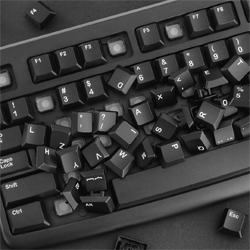|
REGISTRATION REQUIRED
exhibitor q&a
Help!
Digital Events

ILLUSTRATION: MARK FISHER
Q.
Our online event will have multiple speakers providing
live and/or canned content
captured from their home offices. What items must I equip them
with in order to ensure brand
consistency and broadcast quality?A.
You can provide the best content in the world, but if video and audio quality are compromised, its impact will be diminished. What's worse, your sub-par presentation could even tarnish your brand. Therefore, it's critical that your presenters have quality equipment. Luckily, the necessary elements are relatively inexpensive, so if your presenters' setups are lacking, it's well worth your spend to purchase quality components
and either gift or loan them the equipment. Here's a quick primer on the top five components at-home speakers need to ensure they deliver primo presentations.Microphone The most important piece of equipment is a high-quality microphone. It's even more critical than a suitable camera. That's because the majority of the content will be relayed audibly as opposed to visually. Sure, the presenter might show videos or slides, but the bulk of the info is delivered via the spoken word. Therefore, you want the best quality microphone you can get within your means. Consider a condenser lavalier microphone that speakers simply clip onto their clothing. A professional option runs $30 to $60. You can also use a studio cardioid condenser with a shock mount arm and pop filter, which mounts to a desk or table and costs approximately $60. Front Lights Next, you need decent front lights. Even the best camera is only as good as the amount of light going into it. To properly light speakers, you want plenty of illumination to bounce off presenters' faces and then go into the camera in front of them. Ideally, position two lights at about a 45-degree angle up and out from the presenter's face with one on the left and another on the right. Two lights are particularly advantageous for people wearing glasses, as they'll prevent some of the glare off the lenses typically caused by a single front-facing light. While ring lights are all the rage, many people prefer an LED desk lamp with a flexible gooseneck that clamps onto various surfaces. These tend to come with a host of lighting options, such as color modes, temperatures, and brightness settings, but the ability to bend them into myriad positions makes them particularly useful for your purposes. You can find these for roughly $40. Another option that might work, and which won't cost a dime, is to simply have the presenter move the recording equipment so he or she is looking toward a north-facing window. While other windows are suitable at various times of day, the north-facing variety will have the most even light throughout the day and likely won't hit speakers with a blast of direct sunlight at any time. Ambient Light or Backlighting To get high-quality shots, you need some depth of field, which means viewers must be able to see what's behind the presenter. Therefore, speakers need good ambient light or soft backlighting that illuminates the background. This lighting should be dimmer than the front lighting so the webcam's automatic aperture doesn't continually need to recalibrate. A simple solution is to secure a third light, just like the two used for front lighting, but to position it so it faces away from the camera and bounces light off the wall behind the speaker. This straightforward solution will make for a far richer image than that of a two-light shot. Webcam Many desktop computers, laptops, and tablets already have quality webcams. But if any of your speakers are using one that shoots at 720p, upgrade to one with 1080p capabilities to ensure the image is crystal clear. Presenters can verify their cameras' resolutions in seconds by going to webcamtests.com. If their setups are lacking, you can secure a decent plug-and-play webcam that shoots in 1080p for about $40. Also note that most smartphones have better cameras than laptops. So if you don't have two Jacksons to spare, speakers who don't need to share their screens may be better off recording via their smartphones. No matter what camera you choose, however, the devices merely capture content. Your presenters are responsible for positioning them properly. Ideally, speakers should stand up – as we all tend to have better posture standing as opposed to sitting – and cameras should be positioned at eye level. To make eye contact with viewers, speakers should look directly at the camera rather than at their screens. Backdrop Depending on your goals and brand guidelines, you may choose to use existing backgrounds in speakers' homes, or you may want to purchase a printed backdrop. However, stay away from virtual backgrounds, which are unpredictable. They can be fun, but all too often the speaker seems to lose an ear or suddenly grow a distracting unicorn horn. For existing in-home or -office backgrounds, aim for something between super personal (e.g., pets or Star Wars action-figure collections) and hospital sterile, such as a stark-white wall. An uncluttered bookcase or a few shelves on a neutral-colored wall often work well. If you purchase a printed backdrop, consider a lightly patterned design that's not too busy. Also be sure to subtly incorporate your brand while keeping cropping and speaker positioning in mind. For example, you don't want logos or key components on the far corners or bottom half of the background where they may be cropped out of the shot, and logos shouldn't be dead center, as they'll likely disappear behind the presenter. Also, instead of duplicating the same background for each speaker, design and print using a variety of background colors. When captured via different cameras, the same two backgrounds may look like two disparate colors on screen. If your event shows two speakers at once, chances are there will be enough variation in the colors that it'll look like a printing error. With two distinct hues (preferably from the same color family and with the same level of brightness), the color variations will look purposeful as opposed to accidental. Ideally, select a 7-by-7-foot standalone structure, many of which are available through pop-up stand and exhibit suppliers. To ensure that your presenters have the proper equipment and are able to use it effectively, schedule a web-conferencing call with each person several weeks prior to recording. This way you can check the quality of the equipment in use and determine what, if anything, you need to provide each speaker. If you send presenters components, schedule another conference to go through setup and troubleshooting to make sure the gear is up and running properly before they hit "record." With a minimal investment of time and money, you can rest assured that both you and your speakers are putting their best face forward for your event.
— Ben Hawkins, executive producer, content director, and creative producer, George P. Johnson, a Project Worldwide agency, Boston
Help Wanted Send your tough questions about exhibiting to Linda Armstrong, larmstrong@exhibitormagazine.com.
|
|
|
||||||||||||||||||||||||||||
|
|
||||||||||||||||||||||||||||
|
TOPICS Measurement & Budgeting Planning & Execution Marketing & Promotion Events & Venues Personal & Career Exhibits & Experiences International Exhibiting Resources for Rookies Research & Resources |
MAGAZINE Subscribe Today! Renew Subscription Update Address Digital Downloads Newsletters Advertise |
FIND IT Exhibit Producers Products & Services All Companies Get Listed |
EXHIBITORLIVE Sessions Exhibit Hall Exhibit at the Show Registration |
ETRAK Sessions Certification F.A.Q. Registration |
EDUCATION WEEK Overview Sessions Hotel Registration |
CERTIFICATION The Program Steps to Certification Faculty and Staff Enroll in CTSM Submit Quiz Answers My CTSM |
AWARDS Exhibit Design Awards Portable/Modular Awards Corporate Event Awards Centers of Excellence |
NEWS Associations/Press Awards Company News International New Products People Shows & Events Venues & Destinations EXHIBITOR News |
||||||||||||||||||||
|
||||||||||||||||||||||||||||






